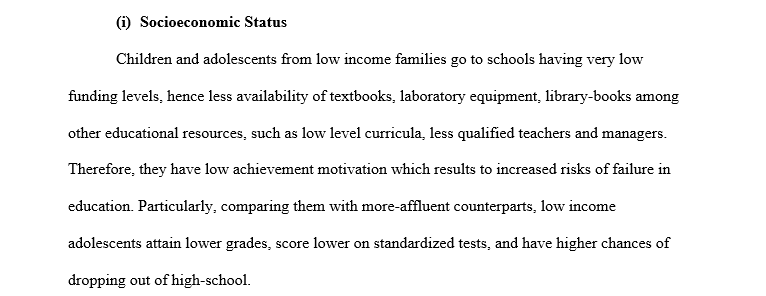Influences on Motivation
Influences on Motivation?
Part one: Content Review (1 page)
Respond to each item. Each response should be concise and between 2–3 paragraphs in length.
Use MS Word to write your responses, and submit your answers to all three questions in one Word document.
Copy and paste each question into the document, so your Instructor can see which questions you are answering.
Choose at least two aspects of culture (e.g. religion, socioeconomic status, geography, race/ethnicity, etc.) and explain how growing up within this culture might affect how a child or adolescent expresses motivation in school. For each aspect of culture, provide at least two specific examples of its potential effect on motivation.
In Chapter 2 of your course text, Donna Tileston describes the construct developed by Robert Marzano to map the mental processes involved in motivation. Define and describe the self-system and the metacognitive system as conceptualized by Marzano. What roles do each play in motivation? What is the relationship between the two? Explain.
What is the cognitive system, and how can knowledge of how the cognitive system works be used to motivate children and adolescents? Provide at least one specific example.
Part two: Contextual Factors That Influence Motivation (1 page)
Where an individual grows up, what television shows he or she watches, what careers his or her parents pursue—these are just a few examples of contextual factors that can influence what an individual learns to value and, in turn, what he or she is motivated to do. In this Discussion, you will consider the complex ramifications of a contextual factor of your choice. You also will reflect on how an awareness of these interrelationships might be used by a professional to foster motivation in children and adolescents. Reflect on the following:
Choose one specific example of any type of contextual factor you learned about this week. It may be real (a magazine ad, a political initiative, a community program, etc.) or hypothetical (e.g., a cultural background, family situation, etc.). How does it fit into the constructs presented this week—Bergin’s individual factors that influence interest and/or Bronfenbrenner’s ecological systems theory?
What are the implications of this factor for the motivation of school-age children and/or adolescents? What are some positive ways it might affect the motivation of young people? Might it affect them in negative ways as well?
How might a professional who is aware of these implications use this knowledge to increase motivation in the children and adolescents with whom he or she works?
With these thoughts in mind, follow the instructions below to post your response to this Discussion topic.
Post or write a description of the specific example of a contextual factor that you chose, including if and how it fits into Bergin’s and/or Bronfenbrenner’s constructs. Then explain how this factor might affect motivation of school-age children and/or adolescents in group or classroom settings, including both positive and negative implications. In addition, explain at least one way that a professional might use awareness of these implications to foster motivation in young people
Solution preview for the order on Influences on Motivation
APA
1050 words
